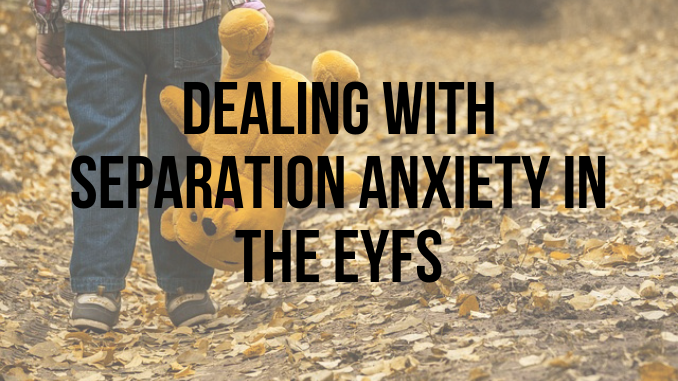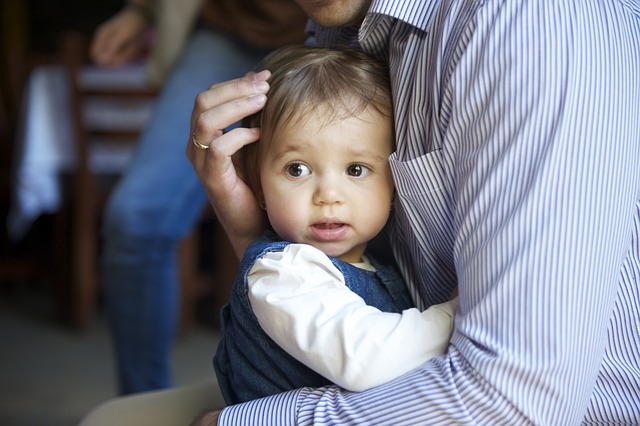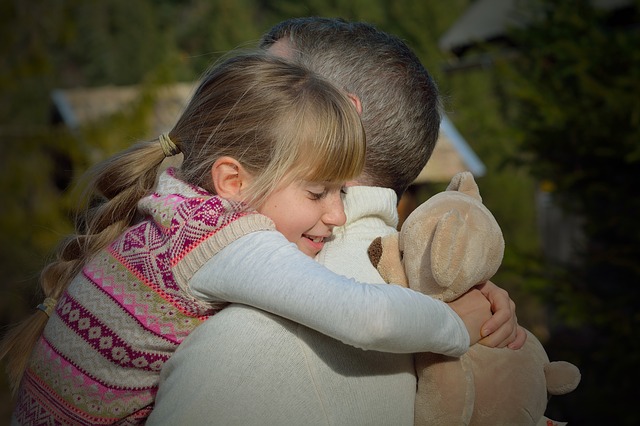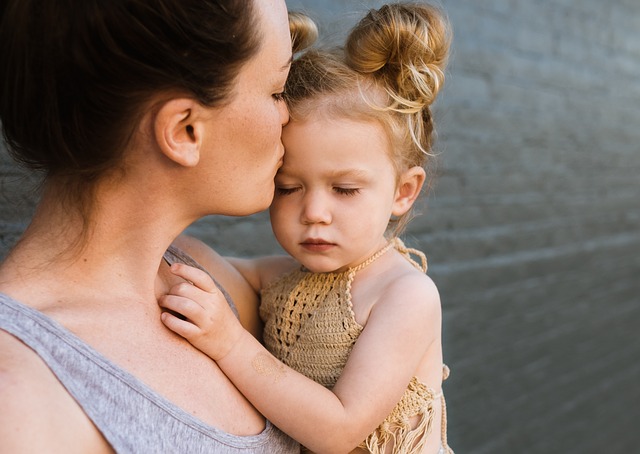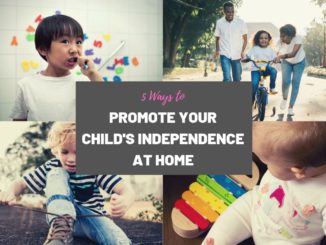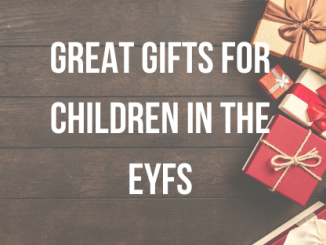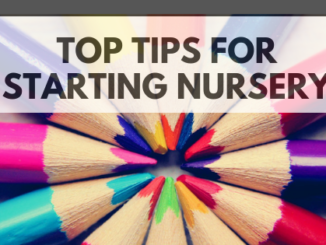Separation anxiety is hard on everyone; the child, the parents and the EYFS practitioners too. It usually starts sometime between 8 and 18 months old but can be expressed by older children too. We see separation anxiety often in Early Years settings, as it is often the first time that a child experiences a prolonged separation from their parent so it is important to find ways to work through this.
What is separation anxiety?
Separation anxiety is a normal stage of psychological development. It usually shows that the child is emotionally healthy and has a very secure attachment to their primary caregiver.
Separation anxiety can manifest in many ways and isn’t always obvious in older children. The classic example is a baby that cries whenever their parent leaves the room or moves away for even a short time.
When they are first born, babies do not know that they are a separate entity to their parent, usually, newborn babies want (and need!) to be held close and nursed frequently. As they get older babies begin to understand that their parent is a separate human being who can move away if they want to.
Separation anxiety shows that a baby has a secure attachment to their parent, and understands that the parent is a separate entity but also understands how much they need them to feel safe and secure.
Bowlby (1969) demonstrated that babies need this kind of secure attachment to a primary caregiver in order to develop optimally and one of the best measures we have of ‘secure attachment’ is to observe a baby who is comfortable in the presence of his or her parent and very upset when his or her parent leaves (Ockwell-Smith, 2016)
Why is it a problem?
In many ways, it’s not. Separation anxiety doesn’t mean that anything is ‘wrong’ with the child, usually quite the opposite! We should expect some level of separation anxiety in most of the children we care for, this isn’t to say that we like seeing children upset! Just that we recognise it as normal, healthy infant behaviour.
Unfortunately, our culture does not yet see this as normal, healthy infant behaviour and many are keen to discourage it. Often this behaviour is described in negative terms as “clingy” and this perception can lead many parents to feel that there is something wrong with their baby.
Furthermore, whilst much of the pioneering research into secure attachment took place in the 1960’s, it has yet to filter down into common parenting information. This leads to a tension between generations with those who parented in the 70’s and 80’s very keen to eliminate “clingy” behaviour.
Compounding the problem is the opinion of many professionals that we need to push children into independence. Whilst we can give children opportunities to exercise their own natural desire to do things independently, to push them into independence is something else entirely and should not be encouraged. Independence emerges when children feel secure enough to experiment with their abilities, and really cannot be forced.
How to help
As EYFS practitioners we are uniquely positioned to help deal with separation anxiety in a positive, developmentally appropriate way. Here are some ways that we can foster understanding, and minimise children’s distress:
Affirming parents:
Many parents will have absorbed the cultural idea that separation anxiety is a negative trait and that “clingy” behaviour is undesirable, they may have experienced tension with family members over this. As Early Years practitioners, it is our job to advocate for understanding children’s normal developmental behaviour, in doing this with separation anxiety we can affirm parents by ensuring that they understand that separation anxiety shows that they have a healthy, secure attachment with their child.
Listening to children:
It can be easy to try and comfort a crying child by saying “You’re okay” or “Don’t cry” but this dismissed their very genuine feelings. Instead, try to validate their feelings and empathise with them.
Settling in sessions:
Settling in sessions and visits to nursery before joining can help minimise the impact of transition and separation anxiety by giving the child something concrete to focus on. Share the daily routine with parents and consider providing them with a visual timetable or a collection of photographs to look back over with their child.
Partnership with parents:
Having clear systems for working in partnership with parents will ensure that you have as much information about the child as possible. At the initial meeting, you should gather as much information as you can such as what their favourite book is, how they settle to sleep, what they like to eat and so on. With all this information in mind, staff can help to meet the child’s needs in an individual way.
Key person system:
A robust key person system should be an integral part of an Early Years setting. Every child should have a named key person and back-up arrangements for when their key person is on annual leave or off sick. A child exhibiting separation anxiety has a secure attachment to their primary caregiver, and secure attachment promotes secure attachment so it is very likely that in time they will form a special bond to their key person too. However, to begin with, it’s important to remember that the key person is a person too and dealing with one, or sometimes several upset children does take an emotional toll. Use your back up arrangements to ensure that the key person gets a quick breather now and again.
Encourage comforters:
Many children have comfort toys or blankets that they like to carry around with them. If they don’t already have one perhaps suggest that the parents use one for a few months before starting nursery so that the child can bring something with them that reminds them of home.
Professional love:
Dr Jools Page (2014) developed the concept ‘Professional Love’ as a way for practitioners to talk about their feelings for the children they care for in Early Years Settings. Usually, we are loco parentis for these children and wish to act in the same way that a loving parent would. Historically some settings have shied away from cuddling for fears of allegations but comforting touch is vital for healthy development. For a child experiencing separation anxiety cuddles, snuggling up to read or maybe even babywearing can help to ease the child’s stress.
Minimise other transitions:
Toilet training, weaning from the breast or transitioning to a toddler bed is often initiated by parents around the same time that children begin nursery school. As practitioners, we should actively discourage this. Recent neuroscience findings show just how un-developed the regulatory part of the brain is during childhood, in particular in the EYFS (Klein, 2014) Children struggle with moving from one thing to another, transition, because their brains are wired for consistency and routine. Heaping transition on top of transition makes it more of a struggle for children to cope.
A positive goodbye:
Encourage parents to say goodbye, rather than sneak out, and ask them to tell their child what they will do later. This means they will have something positive to look forward to doing with their parent later on. By giving children experiences of saying goodbye then having happy reunions, they are learning an important life lesson (Rudkin, as cited by NHS, n.d)
As Early Years practitioners, it is important to understand separation anxiety for what it is: a sign of healthy attachment to a primary caregiver and to deal with it by promoting further healthy attachment to staff. We have to recognise that this takes time and is not always an ‘easy’ solution but if the result is a happy child with secure attachment at home and in the setting then it is certainly worth investing the time in.
References:
Bowlby J. (1969). Attachment. Attachment and loss: Vol. 1. Loss. New York: Basic Books.
NHS (n.d.) Separation anxiety-Your pregnancy and baby guide, Retrieved from https://www.nhs.uk/conditions/pregnancy-and-baby/separation-anxiety/
Ockwell-Smith, S. (2016) The Gentle parenting book: How to raise calmer, happier children from birth to seven. Piatkus.
Page, J. (2014) Developing “professional love” in early childhood settings In L. Harrison & J. Sumsion (eds.), Lived Spaces of Infant-Toddler Education and Care. International perspectives on early childhood education and development, vol 11. Dordrecht: Springer

